Schools, Parents, and Community Partnership Enhancing Students’ Learning Achievement
Main Article Content
Abstract
This research aimed to investigate the level of schools, parents and community partnership to enhance the students’ learning achievement classified by school size, and to find guidelines where schools, parents and community participate towards students’ learning achievement. A total of 1,109 respondents constituting school administrators, teachers, parents and community under the Office of Khon Kaen Primary Educational Service Area 1 were involved. This study employed explanatory mixed-method research design. The data analyzed utilizing descriptive type of research and statistical tools such as: mean value, standard deviation and content analysis. The result revealed that in overall, schools, parents and community had participated. It’s found that the most participated part was on implementation, and the least participated part was on evaluation. Regarding school size, it revealed that different size of school caused the difference between the administrating partnership statistically significant at 0.01 level, and after making a comparison of student learning’ achievement, it found that the quality was not statistically significant at 0.05 level. To achieve the students’ learning achievement, the school should provide chances for parents and community to share their ideas, create an evaluating and tracking system to indicate the efficiency of administration, to accelerate, to simplify, and to mobilize the educational resources. The school, parents, and community should show honesty, reliability and respect to each other, and learn to be good leaders and followers which will lead to a good team-working. Improve profession standards and ethics, including establishing teachers’ connection.
Â
Keywords: parent-community partnership, students’ learning quality, primary school
Downloads
Article Details
Authors who publish with this journal agree to the following terms:
- Authors retain copyright and grant the journal right of first publication with the work simultaneously licensed under a Creative Commons Attribution License that allows others to share the work with an acknowledgement of the work's authorship and initial publication in this journal.
- Authors are able to enter into separate, additional contractual arrangements for the non-exclusive distribution of the journal's published version of the work (e.g., post it to an institutional repository or publish it in a book), with an acknowledgement of its initial publication in this journal.
- Authors are permitted and encouraged to post their work online (e.g., in institutional repositories or on their website) prior to and during the submission process, as it can lead to productive exchanges, as well as earlier and greater citation of published work (See The Effect of Open Access).
References
References
Arambewela, R., & Hall, J. (2009). An empirical model of international student satisfaction. Asia Pacific Journal of Marketing and Logistics, 21 (4), 555–569.
Bohm, A., Davis, D., Meares, D., & Pearce, D. (2002). The global student Mobility 2025 Report: Forecast of the Global Demand for International Education. Canberra: IDP.
Bouwel, L., & Veugelers, R. (2009). The determinants of student mobility in Europe: the quality dimension. European Journal of Higher Education, 3 (2), 2.
Bracht, O., Engel, C., Janson, K., Over, A., Schomburg, H., &Teichler, U. (2006). The Professional value of ERASMUS mobility. International Centre for Higher Education Research (INCHER-Kassel). Kassel: University of Kassel.
Caruso, R., & de Wit, H. (2013). Determinants of Mobility of Students in Europe: a preliminary quantitative study. Munich Personal RePEc Archive. Retrieved from https://mpra.ub.uni-muenchen.de/49808/1/MPRA_paper_49808.pdf
Clyne, F., & Rizvi, F. (1998). Outcomes of Student Exchange. Canberra: IDP Education Australia.
European Commission COM (2009) 329 final. (2009, 8 July). Green Paper – Promoting the learning mobility of young people. Retrieved from http://eur-lex.europa.eu/legal-content/EN/TXT/?uri=COM:2009:0329:FIN
European Commission/EACEA/Eurydice. (2012). The European Higher Education Area in 2012 – Bologna Process Implementation Report. Retrieved from http://www.ehea.info/uploads/(1)/bologna%20process%20implementation%20report.pdf
Eurostat. (2014). Europe 2020 indicators – education. Retrieved from http://ec.europa.eu/eurostat/statistics-explained/index.php/Europe_2020_indicators_-_education#Younger_people_show_higher_educational_attainment_levels
Eurostat. (2015). Mobility of students in Europe. Retrieved from http://ec.europa.eu/eurostat/tgm/table.do?tab=table&init=1&plugin=1&language=en&pcode=tps00064
Eurostat. Tables, Graphs and Maps Interface (TGM) table. Retrieved from http://ec.europa.eu/eurostat/tgm/table.do?tab=table&init=1&plugin=1&language=en&pcode=tps00064
Frew, C. (2006). An International Educational Literacy: Students, Academics and the State. Journal of University Teaching and Learning Practice, 3 (1), 24–33.
Gonzalez, C. R., Mesanza, R. B., & Mariel, P. (2011). The determinants of international student mobility flows: an empirical study on the Erasmus programme. Higher Education, 62 (4), 413–430.
Granovetter, M. (1983). The Strength of Weak Ties: a Network Theory Revisited. Sociological Theory, 1, 201–233.
Guscinskienė, J., & Ciburienė, J. (2013). Socialinio kapitalo ir studentų judumo sąveikos plėtotė. Competence of contemporary specialists: the unity of theory and practice: 7th international conference proceedings, 7, 142–147.
Kaniusonytė, G., Truskauskaitė, I., & Gervinskaitė, L. (2012). Tarptautinis mobilumas ir asmenybės bruozai. Tiltai, 3, 19–34.
Kelo, M., Teichler, U. & Wachter, B. (2006), EURODATA – student mobility in European higher education. Retrieved from http://www.aca-secretariat.be/index.php?id=77
Lifelong Learning Programme. (2014). Erasmus in the Baltic countries 2007-2013. Retrieved from http://archimedes.ee/wp-content/uploads/2015/05/Erasmus-in-the-Baltic-countries.pdf
MOSTA. (2013). Lietuvos studijų bukles apzvalga. Retrieved fromhttps://www.smm.lt/uploads/lawacts/docs/691_405fd570b74e696ece7f277c7d12aea7.pdf
Rivza, B., & Teichler, U. (2007). The Changing Role of Student Mobility. Higher Education Policy, 20 (4), 457–475.
Rodrigues, M. (2012). Determinants and Impacts of Student Mobility: A Literature Review. Luxembourg: Publications Office of the European Union, 8–10.
Tremblay, K. (2005). Academic Mobility and Immigration. Journal of Studies in International Education, 9 (3), 196–228.
Verbik, L., & Lasanowski, V. (2007). International Student Mobility: Patterns and Trends. London: the Observatory on borderless higher education.
Wiers-Jenssen, J. (2002). Norwegian Students Abroad – Experiences of Students from Europe‘s Northern Boundary. 16th Australian International Education Conference – New times, New Approaches. Hobart, Tasmania.
